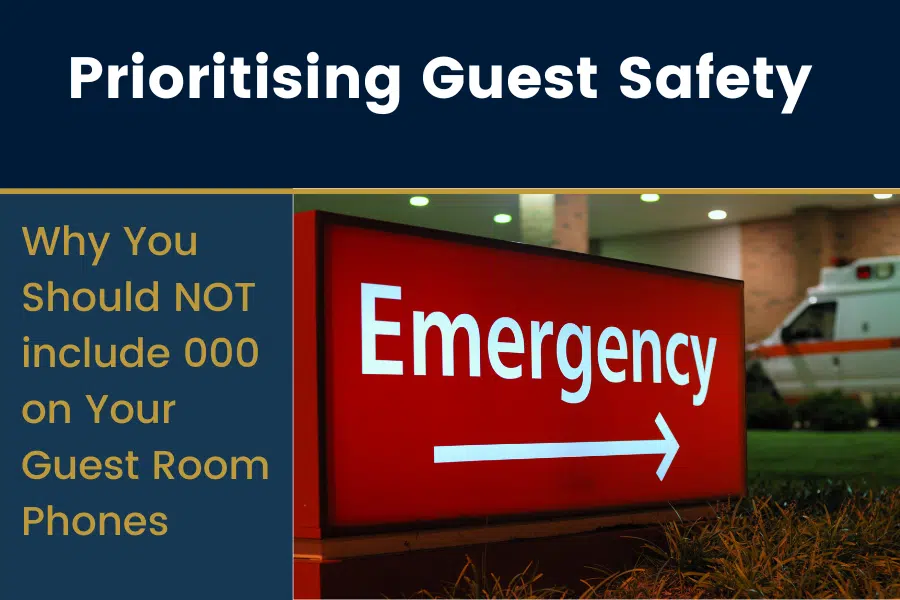In the realm of Australian Hotel Emergency Call Protocols, the management of emergency calls is a pivotal aspect of guest safety for hoteliers in Australia. This approach starkly contrasts with practices in the United States, where Australian emergency services recommend a distinct strategy. It’s crucial for hoteliers to understand and implement this approach to ensure the utmost care for their guests and to adhere to local compliance standards.
Australian Approach: Routing through Reception
Under these Australian Hotel Emergency Call Protocols, it’s advised that hotels direct emergency calls (000) through the hotel’s reception. This is beneficial for several reasons: first, if a guest is uncertain of the required service or cannot communicate or recall their room number, reception can swiftly provide these vital details. Second, it reduces the risk of accidental emergency calls. Lastly, it guarantees that the hotel is promptly informed of any emergency situation, preventing scenarios where emergency services arrive without the hotel’s knowledge. Implementing this reception-centric method is key to ensuring timely assistance to guests, which can be crucial in life-saving situations.
Advantages of Reception Routing in Australia
 Clarity of Location
Clarity of Location
Receptionists can quickly relay the caller’s room number to emergency services.
Reducing False Alarms: Screening calls at reception helps in limiting prank or non-emergency calls to the services.
Balancing After-Hours Emergencies
Hotels without 24-hour reception might consider the pros and cons of direct “000” access, but it’s essential to note that emergency numbers are usually displayed in evacuation plans for genuine emergencies.
US Perspective: Direct Dialling and Location Reporting

Why the Australian Recommendation Matters
For Australian hoteliers, prioritising the reception-routed protocol aligns with the local emergency services’ preferences and addresses potential risks associated with direct emergency calls. This approach considers situations where a guest might be unable to provide their location or may not be clear on which emergency service they require. The reception method ensures a quicker and more effective emergency response. It also avoids the possibility of the guest or their children accidentally dialling emergency services.
Why Doesn’t Australia Adopt the US System?
At this point in time, it’s not technically possible. The major telecommunications carriers do not have the protocols necessary to transmit the location-specific data such as room numbers and that is not likely to change soon due to privacy concerns.
Adapting to Regional Emergency Call Protocols
It’s essential for hoteliers to align with the emergency call standards and best practices relevant to their region. In the United States, not only is direct emergency calling a legal necessity, but there is also a requirement for automated systems that notify reception staff and communicate the caller’s room number to emergency services. In contrast, the most suitable approach for Australian hotels involves emergency calls being routed through reception. This intermediary system ensures that the room number is automatically communicated to reception staff, who are immediately alerted to the emergency. When reception then contacts emergency services, they can provide the precise location of the guest in need. This process guarantees that emergency services can respond swiftly and effectively.
Conclusion: Tailoring Emergency Protocols for Optimal Safety
In conclusion, it’s crucial for Australian hoteliers to implement emergency call protocols that align with local recommendations. By routing emergency calls via reception, hotels can ensure swift assistance to their guests, thereby fulfilling their duty of care and adhering to regional best practices.
Enhance Your Hotel’s Communication Solutions
Considering an update to your hotel’s guest room phones? We’re here to help. We offer a diverse range of phone options to suit your specific requirements. Whether you’re looking for the reliability of corded phones, the flexibility of cordless models, the innovation of SIP technology, or the simplicity of analogue systems, we have solutions that cater to every need.
Beyond functionality, we understand the significance of your hotel’s brand identity. Our team is dedicated to providing customisation options that ensure your guest room phones are not just a communication tool, but also a reflection of your brand’s ethos and commitment to guest experience.
For a seamless integration of style, functionality, and brand consistency in your guest rooms, feel free to connect with us. We’re here to assist you in finding the right communication solutions that align with your hotel’s standards and enhance your guests’ stay. To connect, please get in touch via phone +61 2 8317 4000, or book a time for a complimentary 15-minute Tech Chat, just click here.
Frequently Asked Questions
A: Australian emergency call protocols recommend routing emergency calls through hotel reception, whereas US protocols, under laws like the Ray Baum’s Act and Kari’s Law, mandate direct 9-1-1 dialling with detailed location reporting. Understanding these differences is crucial for Australian hoteliers to ensure guest safety and compliance with local standards.
A: Routing emergency calls through reception in Australian hotels ensures that if a guest is unable to communicate their location, reception can quickly provide this information to emergency services, reducing response time and potentially saving lives.
A: Australian hotels are recommended to route emergency calls through reception, as opposed to the direct 9-1-1 dialling required in the US. This approach is preferred by Australian emergency services to ensure quick location identification and efficient response.
A: For hotels without 24-hour reception, it’s important to balance the provision of direct “000” access with the preferred method of routing through reception. Emergency numbers should be displayed in evacuation plans, and hoteliers should assess the best approach for their specific setting.
A: Australian hoteliers should consult with telecommunications experts to implement systems that allow efficient routing of emergency calls through reception while ensuring the room number and location of the caller can be quickly identified and communicated to emergency services.
A: We suggest that you have a discussion and share why the US has certain requirements and that in Australia, the recommended option is to have emergency calls routed to Reception. Feel free to share this article with them! We are confident that when they appreciate the risk associated with Emergency services attending a property and no-one knowing the location of the caller that the most appropriate protocol is to have calls routed to reception. At the end of the day, emergency protocols are about minimising risk and maximising the chance that the right services are available to people as quickly as posible.


 Clarity of Location
Clarity of Location